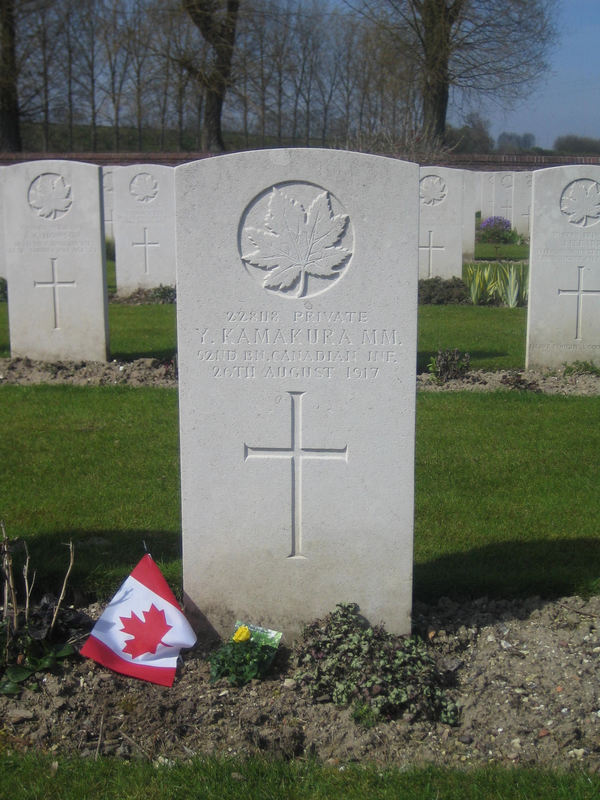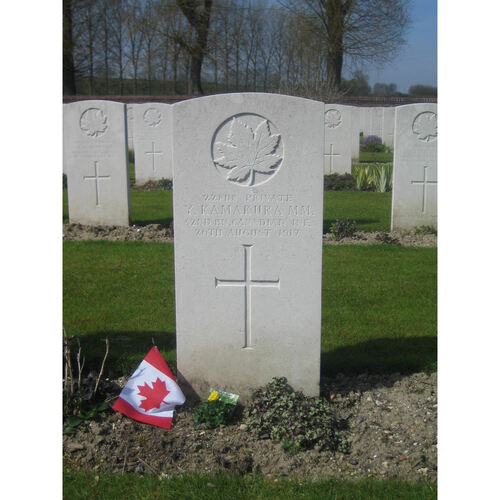
Source: Link
KAMAKURA, YOICHI, railway worker and soldier; b. 21 March 1882 in Hiroshima, Japan, second son of Heizaburo Kamakura and Morito —; killed 26 Aug. 1917 near Lens, France.
From the late 1870s Japanese had settled in British Columbia, where they were discriminated against by the white population and were not allowed to vote. When World War I broke out in August 1914 Japan was an ally of Britain, and Japanese Canadians volunteered for service in British Columbian battalions. They were, however, turned away because whites feared that if Japanese donned military uniform they would demand the franchise and equality. Undeterred by the refusal of local authorities to enlist Japanese, the Canadian Japanese Association in Vancouver, headed by Yasushi Yamazaki, who was also editor and publisher of the community newspaper the Tairiku Nippo, organized the Canadian Japanese Volunteer Corps and in May 1915 offered its services to Prime Minister Sir Robert Laird Borden*. Borden thanked the association and referred the offer to Samuel Hughes*, the minister of militia and defence, and the British and Japanese governments. In the meantime about 200 men began training in Cordova Hall under the direction of Captain Robert Colquhoun, commanding officer of No.19 (Vancouver) Company, Canadian Army Service Corps. One of them was Yoichi Kamakura, who had come to Canada in 1908 and had found employment with the Canadian Pacific Railway cleaning engines.
The volunteers were kept busy with close-order drill and physical training, but as the months passed with no further word from Ottawa the men became bored and restless. When the corps was criticized in March 1916 by a rival Japanese community newspaper as impractical and pointless, the men smashed the newspaper’s office and plant; eight of them were arrested and fined or imprisoned. The “riot,” as it was called in the daily press, started a series of official inquiries about the corps. Major-General Willoughby Garnons Gwatkin*, the chief of staff of the militia, agreed that Japanese could serve but thought the corps was too small to be of use. Although Yamazaki travelled to Ottawa in an attempt to persuade officials to accept it, he was unsuccessful, and on 29 April 1916 Gwatkin declined the offer of service, informing the association that the British cabinet had questioned whether the Japanese population in British Columbia could raise and maintain a battalion at its full strength of 1,000 men.
Kamakura, a strong-minded individual, had already headed for Alberta to see if he would be accepted there, and on 6 April he enlisted in the 13th Canadian Mounted Rifles Regiment in Calgary. Word quickly got back to British Columbia that Japanese were welcome in the Alberta battalions, and men crossed the Rockies to enlist in the 13th CMR and the 175th, 191st, and 192nd Infantry battalions. The 13th CMR, with 42 Japanese in its ranks, left for England on 22 June. It was broken up on arrival, and the Japanese joined the 52nd Infantry Battalion in France on 3 October, going immediately into action at the battle of the Somme. The first Japanese Canadian casualty was Niichi Ikeda, wounded on the 7th, and the next day Teikichi Shichi was killed.
A member of C Company, Kamakura was awarded the Military Medal on 4 July 1917 for an action the previous month. He was in the Lewis machine-gun crew of his platoon, and he had advanced with it, “firing the gun from the hip as they advanced, and by his well directed fire enabled his platoon to make their way through a mass of heavy and uncut wire, and on reaching the final objective succeeded in inflicting many casualties on the enemy, who were retreating in disorder.” Kamakura was killed in action on 26 Aug. 1917, the day after the end of the battle of Hill 70. He is buried in Aix-Noulette Communal Cemetery Extension, and two of his Japanese comrades rest near him. Of the 42 Japanese who enlisted in the 13th CMR, 14 were killed and 23 wounded. A total of 55 Japanese Canadians never returned home. In 1931 the government of British Columbia reluctantly granted the franchise to the returned veterans. Their sacrifice, however, did not win it for all Japanese Canadians.
Details concerning the Japanese Canadian veterans were drawn from interviews conducted by Roy Kawamoto with the late Masumi Mitsui of Hamilton, Ont., transcripts of which are in the author’s possession. Sergeant Mitsui was president of the Japanese Canadian Branch No.9 of the Royal Canadian Legion, Victoria, when the returned veterans were granted the franchise in 1931, and the longest-surviving member of the volunteer corps, dying in 1987 in his 100th year.
Commonwealth War Graves Commission (Maidenhead, Eng.), Cemetery reg., index no.Fr.480 (Aix-Noulette Communal Cemetery Extension, France) (copy at the Commonwealth War Graves Commission, Canadian Agency, Ottawa). NA, RG 24, 4740, 6584; RG 150, Acc. 1992–93/166, file 228588. Tairiku Nippo/Continental News (Vancouver), 1916–19. Roy Ito, We went to war: the story of the Japanese Canadians who served during the First and Second World Wars (Stittsville, Ont., 1984). Sachimaru Morooka, Arasu sensen e [At the battle of Arras] (Tokyo, 1935). Jinshiro Nakayama, Canada no Hoko [The treasure of Canada] (Tokyo, 1920). G. Nishi, Sokuseki [Footsteps] (Tokyo, 1942) [a biography of Yasushi Yamazaki].
Cite This Article
Roy Ito, “KAMAKURA, YOICHI,” in Dictionary of Canadian Biography, vol. 14, University of Toronto/Université Laval, 2003–, accessed June 2, 2025, https://www.biographi.ca/en/bio/kamakura_yoichi_14E.html.
The citation above shows the format for footnotes and endnotes according to the Chicago manual of style (16th edition). Information to be used in other citation formats:
| Permalink: | https://www.biographi.ca/en/bio/kamakura_yoichi_14E.html |
| Author of Article: | Roy Ito |
| Title of Article: | KAMAKURA, YOICHI |
| Publication Name: | Dictionary of Canadian Biography, vol. 14 |
| Publisher: | University of Toronto/Université Laval |
| Year of revision: | 1998 |
| Access Date: | June 2, 2025 |



